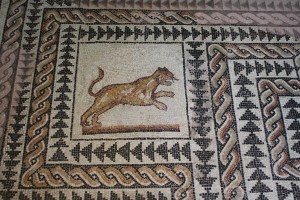Lecture on February 7th. given by Christopher Bradley
Christopher began his fascinating talk by explaining the presence of mosaics in Roman homes – how they were a common form of decoration in Roman houses from Morocco to Turkey. He explained how they captured the life of the people and are such a valuable insight into Roman life.
Christopher then gave us a brief history of mosaics explaining that though they are difficult to date.there are clues within the mosaics themselves. One of the earliest mosaics is from Turkmenistan.  Later on (3000 years ago) the pillars in Mesopotamia were decorated -one famous site that has recently been opened up is in Ephesus displays amazing wall decoration. The trading Phoenicians then began creating mosaics. They also were creating patterned floor surfaces like carpets. The Macedonian Greeks created pictures with natural pebbles and as the availability of pebbles was limited by the 3rd. and 4th. centuries B.C. they began to cut pieces of stone and use these.
Later on (3000 years ago) the pillars in Mesopotamia were decorated -one famous site that has recently been opened up is in Ephesus displays amazing wall decoration. The trading Phoenicians then began creating mosaics. They also were creating patterned floor surfaces like carpets. The Macedonian Greeks created pictures with natural pebbles and as the availability of pebbles was limited by the 3rd. and 4th. centuries B.C. they began to cut pieces of stone and use these.
The Romans mosaics were mainly on the floor and wall mosaics in Roman houses were not common.The main purpose was to provide a flat walking surface (eg. Fishbourne and Lullingston in Kent )  Often a family would work on a mosaic together as in the ones in El Djem in Tunisia. Initially they were also to make a statement or give a warning. (as with the picture of the dog in Pompeii indicating ‘beware of the dog’ ) The signs of the fishsellers are also to be seen in Pompeii.
Often a family would work on a mosaic together as in the ones in El Djem in Tunisia. Initially they were also to make a statement or give a warning. (as with the picture of the dog in Pompeii indicating ‘beware of the dog’ ) The signs of the fishsellers are also to be seen in Pompeii. It is fascinating that the structure of a villa may have gone but the mosaic is still there. (as in Oudna in Tunisia)
It is fascinating that the structure of a villa may have gone but the mosaic is still there. (as in Oudna in Tunisia)
Copies of masterpieces were often inserted into mosaics and these ‘Emblemata’ would be produced in a workshop and handed down through families and bought and sold separately.
One of the most famous mosaicists was Sosus from Pergammon. Schools sprang up all over the Roman Empire, each with its own particular style. One style was Opus Sectile which was very fine figure work alternating with slabs.  Another style was Opus Vermiculatum which used very small pieces of tesserae which allowed fine gradations of colour.
Another style was Opus Vermiculatum which used very small pieces of tesserae which allowed fine gradations of colour.
The 3rd. century was the pinnacle of Roman Mosaics. Those in Tunisia (Bulla Regia) were particularly impressive because of the proximity to Rome- even those in Morocco were not as good; and by the time you get to Britain they were not really good at all. (e.g.Rudston in Yorkshire)
Patterns were not so difficult to recreate as portraits however some are amazing (El Djem in Tunisia ) There were also mosaics depicting plays and gladiatorial combats ( e.g. Villa Borghese in Rome ) To get the mosaics on the wall it was sometimes necessary to cut them into parts. There is an excellent example in Leptis magna in Libya. and one showing chariot racing in Lyon. Mosaics were rarely amusing but the one in Villa Armerina is great fun.
Christopher concluded by telling us that the story of Roman mosaics is not over as new mosaics are still being found
